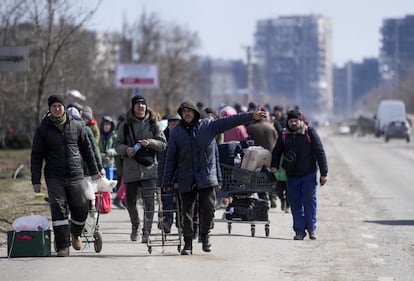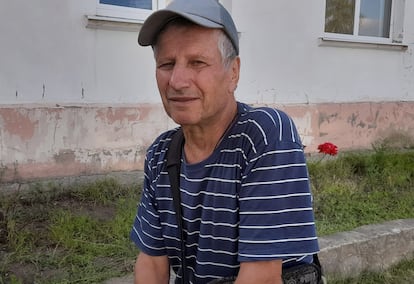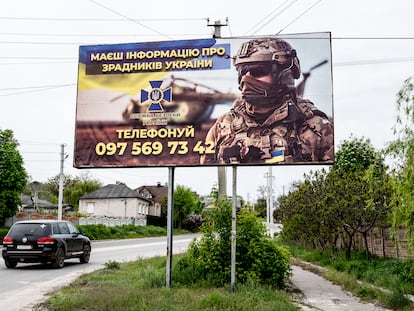Ukrainians flee occupied territories through the only open Russian border crossing
Almost 18 months after the start of the war, a humanitarian corridor between the Russian city of Belgorod and Sumi in northeastern Ukraine opens a window of opportunity for trapped citizens


Yelena, 63, had never left Krasnodon, in Luhansk province. Not when the Russians arrived in February 2022, nor nine years ago, during the occupation of the Donbas region during the 2014 conflict. You have to strain your eye to see on which side of the border Yelena’s town lies. She is traveling alone and is exhausted. “I am very tired of this situation and I want to be with my children,” she says. “They are already waiting for me; I spoke to them today.” Yelena is excited because she will see them very soon. She is in an aid center in the Ukrainian town of Krasnopillia, near the Pokrovka border crossing, in the northeast of the country. She has just crossed over from Russian-occupied territory. Yelena is one of about 150 Ukrainian citizens who daily since August 5 have used the only point on the border between Russia and Ukraine that is currently open: a humanitarian corridor through which they can escape from the occupied areas to free territory.
To understand this journey, it is necessary to understand the current geography of Ukraine. The military operation launched by Moscow in 2014 achieved Russian control over a third of the Donbas region, in the east of the country, next to the Russian border, in addition to the illegal annexation of Crimea — in that case practically without firing a shot. The full-scale invasion launched by Moscow almost 18 months ago extended this occupied territory to the southwest, forming a sort of crescent of land in which millions of citizens were locked between the front lines front on one side and the border with Russian-occupied zones on the other. In other words, given the impossibility of crossing the battlefront, the only way to reach unoccupied western Ukraine was to cross the Russian border, continue northwards to neighboring Belarus, and from there, as an example, to the Baltics and Poland, to then re-enter Ukrainian territory. An odyssey.
On August 9, Iryna Vereschuk, Minister of Reintegration of Temporarily Occupied Territories, announced that citizens wishing to return to Kyiv-controlled territory could do so through the humanitarian corridor between the cities of Kolotilivka, on the Russian side, and Pokrovka, on the Ukrainian side. Vereschuk, who is also deputy prime minister, also reported that a second corridor is active, although, in this case, between the Ukrainian province of Volhynia and the Belarusian border.
Six days later, at 8 a.m., Yelena started her journey. “All these years,” she says, “I had to lie, since 2014.” Shortly after Russian troops appeared in Luhansk that year, her daughter left for Kharkiv. Later, her son would follow. She remained until she decided enough was enough. On August 15, Yelena crossed from Krasnodon (renamed in 2016 as Sorokyne) to the Russian province of Belgorod. It took her 12 hours to reach Kolotilivka, en route north, parallel to the border between the two countries. The hardest part awaited: the Russian filtering process, two hours of interrogation before she was allowed through to the Ukrainian border control, two kilometers away on foot. “It was very hard,” she says. “They were asking me if I supported Russia, their ‘special operation;’ I had to lie and tell them yes so they would let me through.”
According to the Ukrainian government, between 150 and 200 people have passed through the Kolotilivka-Pokrovka crossing daily since August 5. Details of how and when this crossing was first opened, and why it was closed on July 22 and reopened two weeks later, are scarce. This is largely because Kyiv maintains that there is no communication with Moscow. Katerina Arisoi, 36, head of Pluriton, the organization that set up the assistance center in Krasnopillia, says that the corridor has been functioning for months, but few knew about it; that it depends on whether the Russians are letting people through. Now, information seems to be flowing to the occupied territories. “People come more because they know there is assistance here,” Arisoi notes.

Several minibuses arrive at this center from the Pokrovka pass, which is sealed with special zeal by the authorities for security reasons. The Krasnopillia facility in Sumi province is not closed; the presence of law enforcement is relaxed, but inside security is tighter. Access is restricted in the area used by the army, the police, and the Security Service of Ukraine to carry out their own filtration process. New arrivals wait seated in a room with registration papers in hand. Upstairs, those who have finished can go to lunch. Serhi Bondarenko, a septuagenarian, doesn’t mind talking to the press while he eats. He says he is from Donetsk before he is cut off by the authorities. While the interrogation process is ongoing, it is not recommended to talk to a reporter.
Anatoli Oleinik, 65, is also hungry, but he is done with his interview and can chat. His journey began in the small town of Olkhovatka, in Donetsk province, in the heart of that crescent controlled by Russian troops. He says that in his municipality, everything was fine back in 2015, but that is not the case now. His trip across the Russian border cost him 22,000 rubles, about $235. He left with his wife, Galina, 66. She is shy and doesn’t want photos, but finally agrees with a smile to let her husband pose. The two of them are going to join their daughter in Kharkiv.
Filtration process
Perhaps Katerina Arisoi was right when she said that those in the occupied territories have now learned they can flee if they wish through the Kolotilivka-Pokrovka corridor. Anatoli and Galina started their journey when the information spread around their village. Nicolai, a 68-year-old native of Yenakievo, 20 kilometers from Olkhovatka, tells a similar story. “We gathered a few locals,” he says, “and we came.” His was a very long journey, which has left him exhausted. “We arrived by bus at the Russian border and then had to walk the two kilometers on foot,” he says. In his case, the interrogation at the Belgorod checkpoint, on the Russian side, was quick.
At the Krasnopillia assistance center, the filtration process can take between two and four hours, although there are some who say they were questioned for an entire day. Lieutenant Danilo, 23, who prefers to keep his last name confidential, explains the process: “We record the day they enter, their first name, last name, passport number, where they come from, where they are going...” This data is then cross-checked with a database that is exclusively accessible to the security forces. It may be that there is a family member who is looking for them and they can find that information through this file. Apart from registration, this mechanism is intended to ensure that citizens arriving from enemy territory do not pose a threat to the security of Ukraine. If it is suspected this is the case, responsibility passes to the police to launch an investigation.
Sign up for our weekly newsletter to get more English-language news coverage from EL PAÍS USA Edition
Tu suscripción se está usando en otro dispositivo
¿Quieres añadir otro usuario a tu suscripción?
Si continúas leyendo en este dispositivo, no se podrá leer en el otro.
FlechaTu suscripción se está usando en otro dispositivo y solo puedes acceder a EL PAÍS desde un dispositivo a la vez.
Si quieres compartir tu cuenta, cambia tu suscripción a la modalidad Premium, así podrás añadir otro usuario. Cada uno accederá con su propia cuenta de email, lo que os permitirá personalizar vuestra experiencia en EL PAÍS.
¿Tienes una suscripción de empresa? Accede aquí para contratar más cuentas.
En el caso de no saber quién está usando tu cuenta, te recomendamos cambiar tu contraseña aquí.
Si decides continuar compartiendo tu cuenta, este mensaje se mostrará en tu dispositivo y en el de la otra persona que está usando tu cuenta de forma indefinida, afectando a tu experiencia de lectura. Puedes consultar aquí los términos y condiciones de la suscripción digital.
More information
Archived In
Últimas noticias
Maduro pleads not guilty before the federal court in New York: ‘I am still the president of Venezuela’
A new test can detect Alzheimer’s from a finger prick
UN team enters Sudanese city of El Fasher after paramilitary massacre: ‘It’s like a ghost town’
A recipe for resistance: Indigenous peoples politicize their struggles from the kitchen
Most viewed
- Gilles Lipovetsky: ‘If you want to live better and fall in love, take Prozac, don’t look to philosophy’
- Alain Aspect, Nobel laureate in physics: ‘Einstein was so smart that he would have had to recognize quantum entanglement’
- Alvin Hellerstein, a 92-year-old judge appointed by Bill Clinton, to preside over Maduro’s trial in New York
- Why oil has been at the center of Venezuela-US conflicts for decades
- Maduro’s downfall puts China’s relationship with Venezuela to the test










































